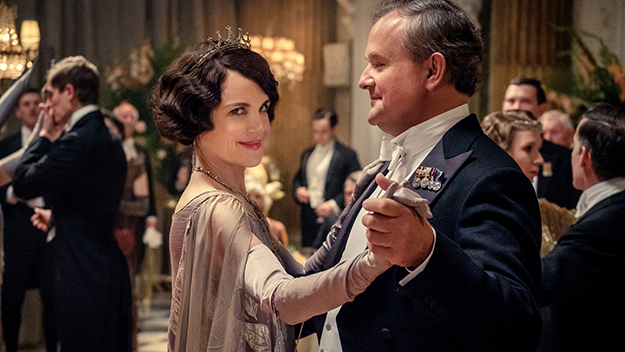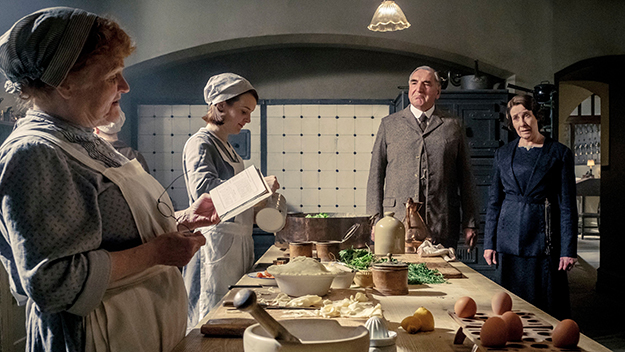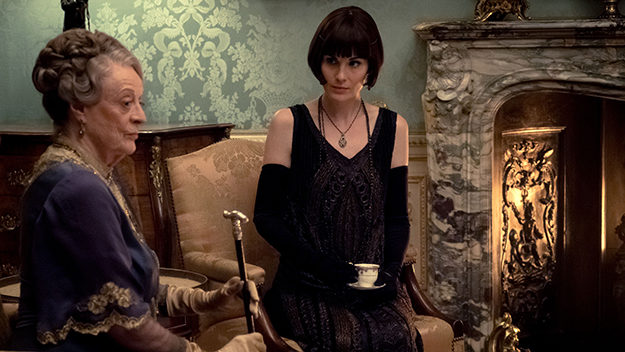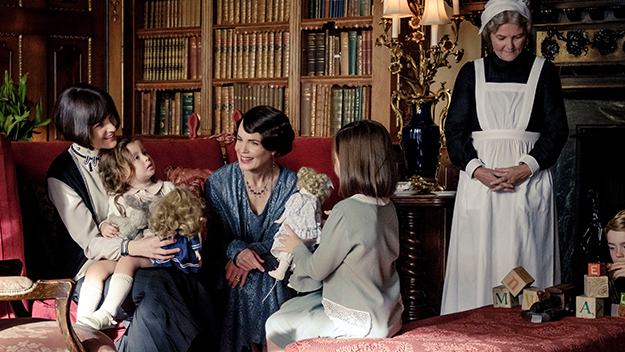Deep Focus: Downton Abbey

Images from Downton Abbey (Michael Engler, 2019)
It’s 1927. The noble Crawley family learns that King George V (Simon Jones) and Queen Mary (Geraldine James) are stopping overnight at Downton Abbey on a trip through Yorkshire. The formerly middle-class Isobel Crawley Grey, Baroness Merton (Penelope Wilton), crisply declares the royal visit “a waste of money.” Her ideological nemesis, Violet Crawley, the Dowager Countess of Grantham (Maggie Smith), responds, with exquisite weariness, “Here we go again.” The American heiress turned Countess of Grantham, Cora Crawley (Elizabeth McGovern), cheerfully asks whether this is, after all, what the monarchy is for: “To brighten the lives of the nation with stateliness and glamour.”
Violet and Cora are both right when it comes to Downton Abbey, the big-screen addition to the benchmark TV series. That resplendent rara avis—a playful, civilized smash—ran for six seasons, fueling many a PBS fund drive before it ended in 2016 (and in most markets, even afterward). In the movie, series creator Julian Fellowes, as sole writer and co-producer, gracefully recreates the sweet and savory, upstairs-downstairs charms of the previous 52 episodes, thanks partly to a score of spirited performers who merrily climb back into their formalwear and livery. (The movie’s radio spots boast about “the original cast” without having to list a single name.) Fellowes doesn’t stint on the nostalgic pomp and circumstance of a stately country house hosting a regal occasion. He also rings up piquant variations on his peerless—and peer-filled—brand of high-and-low comedy-drama.
The TV series set long fuses for its plots, then ignited them against a backdrop of seasonal pursuits (shooting, hunting, balls) and holidays. In a feat of narrative inclusivity, Fellowes concocts a cascade of mini-crises or subplots for his returning performers, within a clear-cut narrative arc. We know the resourceful, relatively eclectic Downton clan and crew can pull together a show of deluxe hospitality in a matter of days. But how will they wrest power from the King’s glorified butler, his Page of the Backstairs (David Haig), who declares that the Buckingham Palace staff will do everything from prepare dinner to serve it? This tug-of-war generates just enough suspense.

It’s a storytelling turn that puts a clever spin on Fellowes’ class-conscious seriocomedy, demonstrating hierarchies within hierarchies, and renewing our rooting interest for our heroes. How would beloved cook Mrs. Patmore (Lesley Nicol) live down the insult of ceding her position to a French chef, Monsieur Courbet (Philippe Spall)? Would Molesley (Kevin Doyle), who temporarily returns from teaching to service to wait on His Majesty, ever recover from the disappointment if he never gets the chance? In an exuberant cameo, Mark Addy, as the delightfully named Mr. Bakewell, conveys the Downton grocer’s giddiness at the prospect of his food touching the lips of the King and Queen.
Without a single family member in existential crisis and the servants relatively stable, we get to see 20 characters in their essence, over the course of a few hectic days. The turns are uneven, but all the actors deliver relaxed yet intensely detailed performances. Michelle Dockery slips into haughty, coolly passionate Lady Mary Talbot née Crawley as if she never left. It’s good fun to see her and Laura Carmichael, Lady Edith Pelham née Crawley, express their mellowing bond—alternately astringent and affectionate—with little more than Mary’s wary gaze and Edith’s glance of skeptical appraisal. Previously, Lady Edith made her most audacious moves in London—especially when she worked as a publisher—but here she comes fully into her own at Downton Abbey. She exudes a bracing clarity as the most modern Crawley of them all, who arrives for the festivities with her husband, Bertie Pelham (Harry Hadden-Paton), sans maid, valet, or nanny.
It’s surpassingly poignant to witness Mary pay respects to Violet as the prime protector of the clan and to hear Violet confess that she always considered Mary the key to Downton Abbey’s preservation rather than her son, Robert Crawley, Earl of Grantham (Hugh Bonneville). Smith has rarely acted with more uproarious offhand authority than she does when plotting to take down “Cousin Maud” Bagshaw (Imelda Staunton), the queen’s lady-in-waiting, who apparently intends to leave her estate to a non-relative, though Robert is her closest blood relative. And she achieves a simple eloquence in her climactic conversation with Mary—a heart-to-heart between women sometimes thought to be heartless. With Mary and former chauffeur and Irish radical Tom Branson (Allen Leech) co-managing the estate, Robert has little to do except brim over with exasperation and, more often, amiability. Here, as in the Paddington movies, bonhomie becomes a Bonneville specialty.

The King’s arrival sharpens everyone’s political attitude. The assistant cook Daisy (Sophie McShera) has become quite the outspoken republican. In the most beguiling side-story, her bright-eyed spunk makes her irresistible both to her footman fiancé Andy (Michael Fox) and to a devastatingly handsome plumber who comes to fix the boiler. McShera has transformed Daisy from the shrinking flower she was as a girl to a combative, twinkling-eyed romantic. She occupies the apex of a possible triangle.
As a self-made member of the Crawley circle, Branson, looking trimmer and more confident, becomes a source of wisdom both for Bagshaw’s maid, Lucy Smith (Tuppence Middleton), who seems alarmingly familiar with her mistress, and, improbably but wonderfully, Princess Mary (Kate Phillips), who is wrestling with the question of whether to leave an unhappy marriage or preserve it for the dignity of the Crown. Branson’s elevation as the man most likely to succeed in a volatile social-political world is a satisfying development. This socialist and Irish nationalist who married and had a child with Lady Sybil (Jessica Brown-Findlay), then lost her to eclampsia, has deepened with loss and age. He abhors political violence (and proves it in an embarrassingly perfunctory sketch of an attempted assassination of the King) and treasures personal virtues like trust and loyalty. His emotional seasoning makes him appealing to Princess Mary, and, even more, to Lucy. The Crawley sisters consider Lucy to be his perfect match.
Beneath the stairs, butler Thomas Barrow (Rob James-Collier), wilts under Lady Mary’s laser stare as she asks why he hasn’t polished the silver for the royal dinner. Suspecting that Barrow may not be in full command of the job, she beseeches her beloved Carson (Jim Carter) to return as interim butler. The payoff comes not with the inevitable friction but with Barrow being freed up to visit another Yorkshire village. Fans who’ve followed Barrow’s bitterness and self-flagellation over the years, including his enrollment in a gay conversion treatment, will find it tremendously moving when he stumbles into a covert gay community and James-Collier’s face opens up as it never has before. The director, Michael Engler, and the cinematographer, Ben Smithard, adopt a looser style and tawnier look that make this sequence register like a rave-up between courtly rituals.
The conflict between the Buckingham Palace and Downton staffs is the most enjoyable confrontation between doppelgangers in recent movie memory. The winds of change sweep into the service quarters and inspire a subversive act. Even Carson ultimately colludes in the scheme cooked up by Anna (Joanne Froggatt) and Bates (Brendan Coyle) to vanquish the supremely snooty interlopers.

Fellowes and Engler choreograph all these figures in a complicated dance that lands everyone exactly where he or she ought to be, whether it’s Lady Mary waltzing in the arms of her beloved husband Henry Talbot (Matthew Goode), who comes back from business in America in time for the royal ball, or Carson proudly marching back to the cottage he shares with his wife, housekeeper Mrs. Hughes (Phyllis Logan). To say that Fellowes and Engler make minimal use of their cinematic tools is, perhaps, an understatement. The movie is full of luxurious displays, but they flub the one visual flourish they attempt—a blurred shot of the Yorkshire Hussars lining up at a distance for the King’s inspection. We expect to see this formidable yeomanry regiment (actually the King’s Troop Royal Horse Artillery) come into a focus from the reviewing stand’s point of view, in a startling epiphany of military glamour. Instead Engler cuts to different angles, diffusing the impact and leaving the action as devoid of perspective as a travelogue. (Similarly, during the regimental parade through the village, the filmmakers obscure the thrill of seeing humble streets filled with bellicose splendor with that ridiculous excursion into anti-monarchist skullduggery.)
During the making of the near-masterpiece Gosford Park (2001), Fellowes must have learned from director Robert Altman how to make an audience laugh with a character’s subtle facial shifts as well as punch lines, and how to float fluidly between servants and blue-bloods, in order to accentuate the gaps and the connections between them. He isn’t a probing or exploratory writer, but he walks us into a fully populated world, based on memoirs of life in the stately homes of England as well as first-hand memories of friends and relatives. We enjoy the contours and the filigree of his production—the way Mary’s gown turns her into an ecstatic Art Deco vision as she whirls across the ballroom floor.
Fellowes gives us a cheery vision of evolutionary change: the born aristocrats swing and sway while the more vital outsiders, Branson and Lucy, dance on a veranda, in twilight. The royal ball is in some ways the optimistic pop-culture variation on the ball at the climax of The Leopard (1963): the aristocratic protagonist, Don Fabrizio Corbera, Prince of Salina, sees his way of life deteriorating before his eyes because of inbreeding and inflexibility; the one sign of hope is his favorite nephew’s bourgeois fiancée; at the end, the prince feels old and defeated.
Lady Mary, though, holds on to the Crawleys’ manor even as the ground slides beneath Downton Abbey. The Crawleys embody feudalism with a human face—and touch.
Michael Sragow is a contributing editor to Film Comment and writes its Deep Focus column. He is a member of the National Society of Film Critics and the Los Angeles Film Critics Association.







